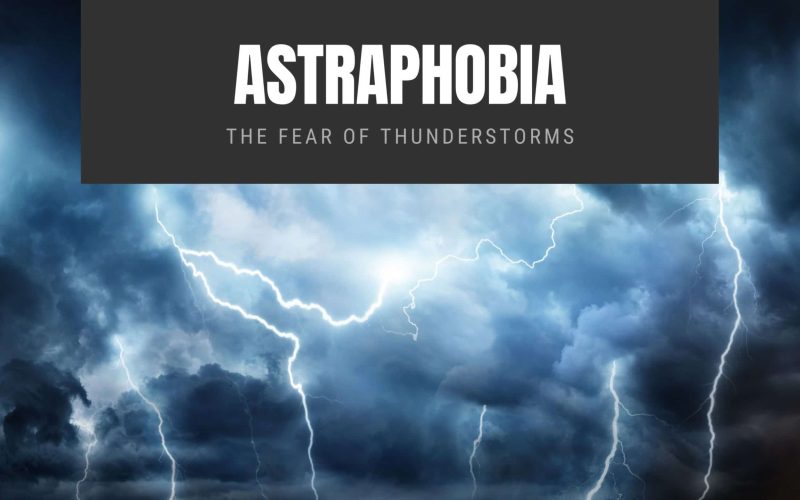People often say that the chances of a person getting struck by lightning are a billion to one, which is relatively impossible.
However, even though the odds are often in our favor, some people still fear being struck by lightning or a thunderstorm, which scientists call Astrophobia.
Astraphobia can be defined as the extreme or deep fear of lightning and thunderstorms. In children, this phobia is often one of the many phobias that are considered common.
Although it is common to say that children are often scared of lightning, research has shown that adults sometimes can have that deep sense of fear. Some studies have also shown that some animals, likewise, can exhibit this kind of phobia.
Sometimes, for adults who have this phobia, this fear didn’t initially begin while they were adults.
Often, adults who have this condition have developed this phobia right from childhood. However, some adults have been seen to develop this fear while growing.
Although storms are a natural phenomenon, this natural occurrence can cause intense anxiety and fear in people who have Astraphobia and can result in the patient having a full-blown panic attack.
Just like most common phobias, Astraphobia is considered to be a specific phobia. Other terms that can be used in place of Astraphobia include astrapophobia, tonitrophobia, brontophobia, or keraunophobia.
Astraphobia is a common phobia that can easily be treated. Just like the other specific phobias, the American Psychiatric Association doesn’t officially recognize Astraphobia as a specific psychiatric disorder.
This means that if you have Astraphobia, you are not going crazy. Astraphobia can easily be treated.
Causes of Astraphobia
Just like other specific phobias, the exact causes of Astraphobia are unknown. However, researchers and doctors have attributed the causes to environmental or genetic.
In other words, if you have a history of psychiatric disorders or other phobias that exist in your family, you may likely develop Astraphobia.
How Do You Know You Have Astraphobia?
Sometimes, it is quite understandable to be afraid of an impending storm. When a storm is coming, normal people will try to cancel all their outdoor plans or, better still, relocate to a place that has shelter and a roof. They also try to stay away from tall buildings.
They also recognize that their chances of getting hit by lightning are almost zero, so they try to take the necessary precautions to stay dry. However, the cases of people with Astraphobia are different.
People who have Astraphobia have a completely different response from what normal people would do.
In some cases, listening to the weather forecast depicting a storm arising creates an in-depth fear.
Even before the storm, some people who have Astraphobia may begin to display signs of panic attacks.
While others may develop panic attacks during or after the storm. Mostly, people living with Astraphobia often start by showing signs of fear, and if care isn’t taken, their anxiety can result in a full-blown panic attack, which can include certain symptoms such as:
- Shaking all over the body, especially on the hands and legs.
- Severe chest pains
- Numbness, especially in the limbs.
- Nausea
- Vomiting
- Fainting in extreme conditions
- Nausea
- Rapid heartbeats (heart palpitations)
- Severe difficulty in breathing
- Racing pulses
- Sweaty palms
- Intense desire to always monitor the weather forecasts
- The overwhelming need to hide away from the storm; hence, people who have Astraphobia are mostly seen in the closet, under the bed, or in the bathroom, where they try to hide.
- The need to always hold onto others for protection and comfort.
- Uncontrollable crying in children.
Astraphobia in children is often a regular occurrence. Usually, doctors don’t even claim or recognize it to be Astraphobia. Most children are often afraid of storms and lightning. Hence, when this occurs, they also try to hide out from their fears.
Some kids may hide out in the bathroom, under their covers, under the bed, or behind a curtain to protect themselves.
Although this phobia is not recognized in children, if, after 6 months, the child continues to be scared of the storm or if the fear is very severe and often inconsolable, the parents must seek medical help for their child.
Risk Factors
Often, scientists say that being a child is a risk factor for developing Astraphobia. Storms are especially scary for kids but tend to outgrow them as they age. Other risk factors that are often associated with Astraphobia include:
1. Autism
Children who have autism have a difficult time adjusting to loud environments and can often scared of the storm. They usually have difficulty controlling their emotions when loud sounds trigger them.
Generally, people with autism have an increased sensitivity to sound and noise. Hence, they are often scared during storms because they often come with loud noises.
2. Having a Genetic Predisposition to Anxiety
Most people who have genetic traits of developing phobias and anxieties may also be at an increased risk of developing Astraphobia.
3. Being exposed to a weather-based traumatizing experience can also be a risk factor. For example, if a person has had an accident that was caused by bad weather or has lost a loved one due to terrible weather conditions, the person may be at risk of developing Astraphobia
Diagnosis
If you have had Astraphobia for 6months or more, and it is beginning to affect your life and daily routine, then it is time for you to seek medical help from your doctor or therapist.
Your verbal accounts of how you feel about the storm and the weather, as well as physical examinations to rule out any underlying medical conditions, should help your doctor diagnose you properly.
However, there is no specific scientific method or medical laboratory test that can prove that you have Astraphobia.
Once you have been diagnosed with Astraphobia, your doctor will recommend a treatment plan that is suitable for you.
Treatments
There are several treatment plans that your doctor may prescribe that can help with your phobia. They include:
1. Cognitive Behavioral Therapy
Cognitive Behavioral Therapy, or CBT, is a form of talk therapy. This form of psychotherapy is often short-term and may be done with one or more therapists at a time.
Sometimes, CBT can also be done in a group, and this helps the patient to know that he/she is not alone in what they are experiencing.
One of the numerous advantages of CBT is that it helps to focus deeply on one specific issue. This is the reason why doctors call CBT a goal-oriented program.
Cognitive Behavioral Therapy often seeks to alter or disrupt the patient’s erroneous and negative thinking patterns and replace them with more positive and rational ways of thinking.
This helps the patient realize that their fear is all in their head. CBT is a gradual process, but it is sure to take effect after the treatment plan has been concluded.
2. Exposure therapy
Exposure therapy is also a part of CBT. Think of exposure therapy as the practical session after the talk or psychotherapy.
Exposure therapy has to do with the therapist, helping the person who has Astraphobia to gradually and in an absolutely controlled manner become exposed to his/her fears.
Exposure therapy allows the patient to confront their fears. However, when a therapist engages in exposure therapy, he gradually exposes the patient to harsh weather conditions and watches how they deal with them.
3. Dialectical Behavioral Therapy (DBT)
Dialectical Behavioral Therapy is a type of therapy that combines both methods and steps used in CBT alongside meditation as well as other relieving mind techniques.
This therapy helps the patient gain some form of control during their panic attacks.
This therapy aims at helping patients who suffer from phobias, especially Astraphobia, to take the time to process and regulate the way they feel as well as their emotions.
Once these people can successfully know how to react adequately to the situation, they most likely won’t develop panic attacks.
4. Acceptance and Commitment Therapy (ACT)
Acceptance and Commitment Therapy simply involves the therapist training the patient to increase their mindfulness regarding their situation and help them know they are in control.
It also helps them improve their coping skills as well as their self-acceptance and that of their condition.
5. Anti-Anxiety Medications
In addition to the therapy sessions that your doctor may ask you to be in, you may also be given anti-anxiety meds.
These medications help to relieve you of whatever stress you may experience during or before the storm begins.
It is important to note that these medications will cure you of Astraphobia. In fact, no medicine can cure you of Astraphobia. However, medications help you to cope properly with your fear and anxiety.
6. Stress Management Techniques
Some stress management techniques have been seen to be mind-friendly. This means that they help you reduce the stress or clog pattern in your head and help you relax.
Some of these techniques (for example, meditations) can put your mind at ease and help you manage your phobia for a long time.
Outlook
Once your fear begins to interfere with your daily life or has been for an extended period (for example, 6 months), you should consult your doctor. The good news is that Astraphobia is a totally treatable condition that can be managed over time to achieve maximum results.
In conclusion, although most specific phobias can be totally distressing and annoying, most of them, including Astraphobia, can be treated. However, knowing you have a problem is the first step towards treatment.
This means that if you think you have Astraphobia, it is essential for you to meet with your therapist as soon as possible to get it treated and return to your daily routine.
References;
- Everything you should know about Astraphobia; Healthline
- Overview of Astraphobia (the fear of thunderstorms); Verywellmind
- Astraphobia; Calmclinic








